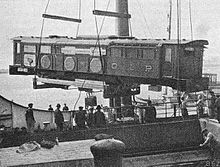GIPR class EA / 2
| GIPR EA / 2 IR WCP-2 |
|
|---|---|
|
Locomotive body of the EA / 2 on the transport bogies
|
|
| Numbering: | GIPR 4025 IR 20024 |
| Number: | 1 |
| Manufacturer: | SLM , Metrovick |
| Year of construction (s): | 1938 |
| Retirement: | 1980s |
| Axis formula : | 2'Bo (A1) |
| Gauge : | 1676 mm |
| Length over buffers: | 16,300 mm |
| Fixed wheelbase: | 2286 mm |
| Total wheelbase: | 11,883 mm |
| Service mass: | 100 t |
| Friction mass: | 60 t |
| Top speed: | 137 km / h |
| Hourly output : | 1562 kW (2124 hp) |
| Continuous output : | 1368 kW (1860 hp) |
| Starting tractive effort: | 150 kN |
| Driving wheel diameter: | 1600 mm |
| Power system : | 1500 V DC |
| Number of traction motors: | 6th |
| Drive: | SLM universal drive |
The class EA / 2 electric locomotive of the Great Indian Peninsula Railway (GIPR), later WCP-2 of the Indian Railways (IR), was an express locomotive for use on the Bombay - Pune and Bombay - Igatpuri railways electrified with 1500 V direct current . It was rebuilt in 1938 with small changes based on the drawings of EA / 1 .
history
In 1922 the electrification of the GIPR began. Powerful locomotives were required to transport the express trains on the mountain railway to overcome the Western Ghats . They also had to be able to reach a speed of 85 miles an hour (137 km / h) - a very high speed for the time. After building three test locomotives, the EA / 1, a design by SLM and Metrovick, was selected for series production and a total of 21 locomotives of this type were delivered.
In 1938 a single replica locomotive with the number 4025 was ordered, which had the same design as the other locomotives, but was still classified in a new series. The electrical equipment from Metrovick was installed in the SLM halls in Winterthur . After the voltage test, the locomotive body was lifted off the drive wheels and the bogies and the motors removed. For the transport it was placed on two special bogies of a low-loader wagon of the SBB and sent by rail to Antwerp , where it was loaded onto the cargo ship to India. In Bombay, the locomotive box was put back on the chassis and brought on its own wheels to the main workshop in Parel of GIPR, where the locomotive was fully assembled and then put into operation.
The locomotive remained in service until the 1980s and was exhibited at the Nehru Science Center in Bombay after it was scrapped .
technology
The locomotive has three individually driven driving axles , a two-axle running bogie at one end and a single running axle at the other end of the locomotive. The Winterthur type bogie had a laterally movable pivot that was centered with springs. The single running axle was combined with the neighboring driving axle to form a Java bogie , which is why the locomotive had the 2'Bo (A1) wheel arrangement and not, as is often written, 2'Co1 '.
Two traction motors each drove a drive axle via an SLM universal drive . The engines were arranged high in the engine room, which on the one hand gave the locomotive a high center of gravity , which was considered to be favorable , and on the other hand protected it from damage when traveling through water during the frequent floods in Bombay. The engines could be removed laterally through maintenance openings in the lower area of the engine room side wall.
The box of the locomotive extended over the entire length of the frame. The engine room between the two driver's cabs was divided into three rooms. The first room contained the braking equipment with vacuum pump and the compressor with air tank, the second room contained the switchgear for the electro-pneumatic control and the third room contained the starting resistors . The approach took place with all six traction motors in series, then two groups of three motors each in series and finally three groups with two motors each in series. In each group, two field weakness levels were available, so that the locomotive had a total of nine continuous speed levels.
Web links
- WCP-1 and WCP-2 Series. In: IRFCA. Retrieved May 8, 2016 (pictures of the locomotive on display at the Nehru Science Center.).
Individual evidence
- ↑ Jakob Buchli: Universal drive "Winterthur" for electric locomotives . In: Schweizerische Bauzeitung . tape 90 , no. 23 , 1927, pp. 294-296 , doi : 10.5169 / seals-41817 .
- ^ Locomotive transport Winterthur-Bombay . In: Schweizerische Bauzeitung . tape 112 , no. 8 , 1938, pp. 90-91 , doi : 10.5169 / seals-49905 .
- ^ The Electric Locomotive Roster: DC & AC / DC Electrics. In: 24 coaches. October 18, 2014, Retrieved May 7, 2016 (American English).
- ^ Side view of the black beauty. In: The Indian Railways Fan Club Photo Gallery. Retrieved May 7, 2016 .
- ^ Announcement from the SLM: Innovations in the mechanical structure of electric express train locomotives . In: Schweizerische Bauzeitung . tape 89 , no. 13 , 1927, pp. 174-175 , doi : 10.5169 / seals-41673 .
- ↑ FJG skin: The history of electric traction vehicles . tape 1 . Springer, Basel 1972, ISBN 3-7643-0525-8 , pp. 35-36 .


